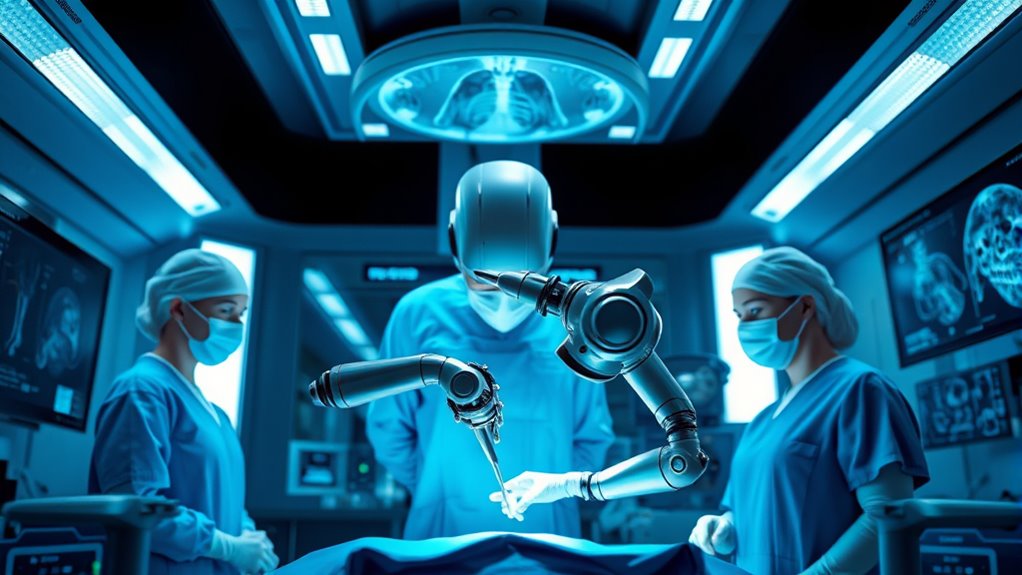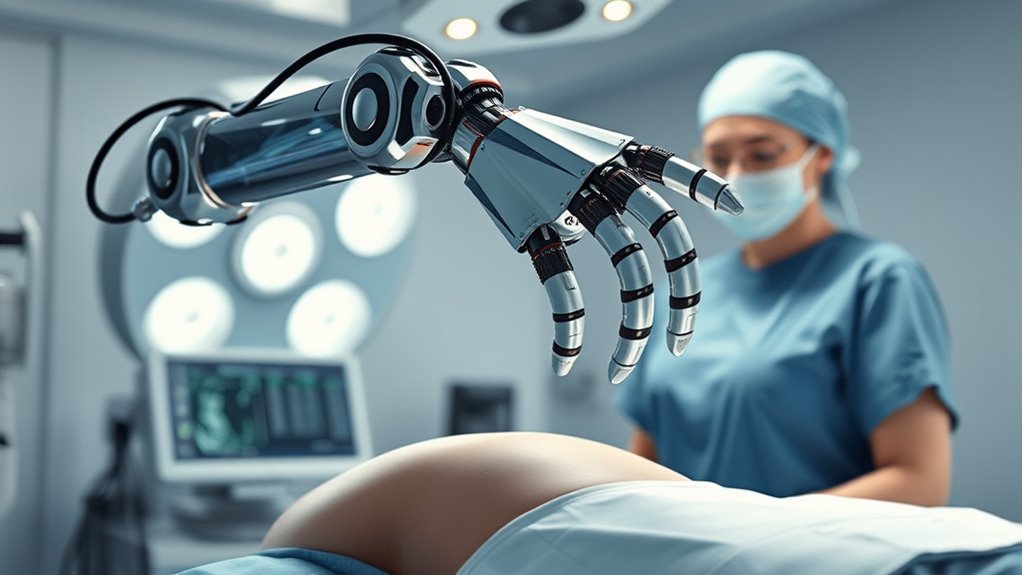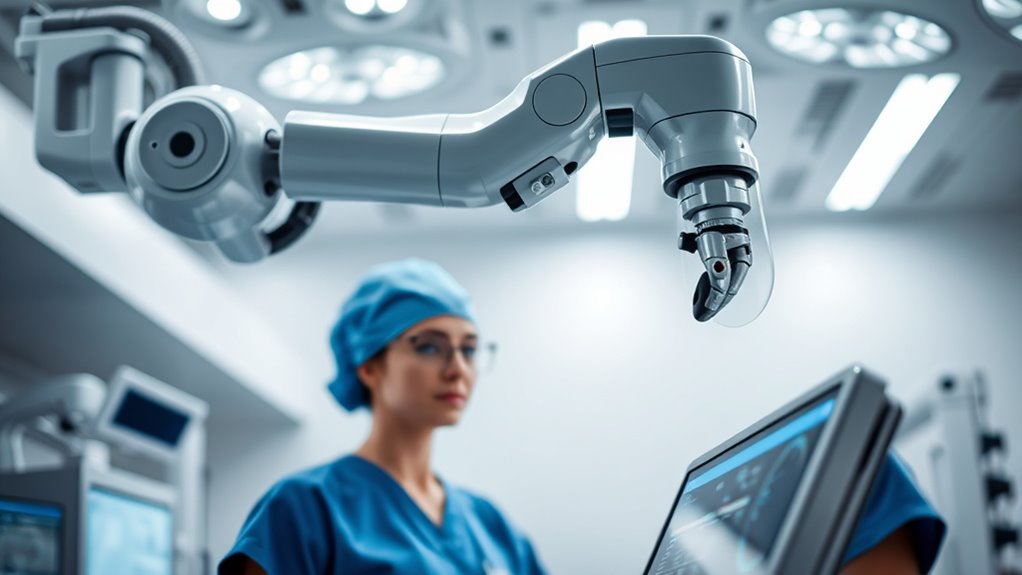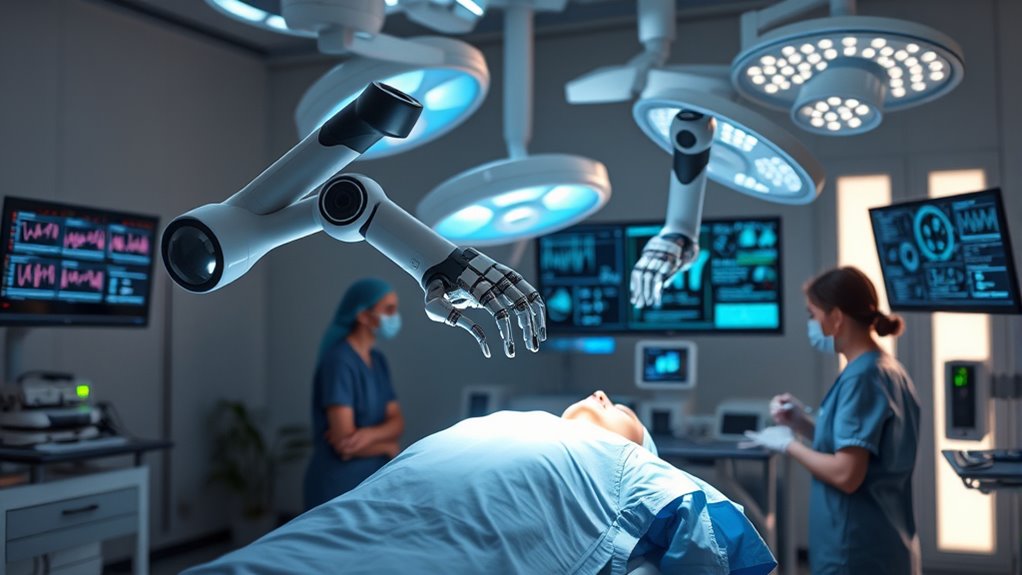As robotic surgery advances, nurses’ roles are evolving rather than diminishing. You’ll find yourself managing complex systems, ensuring patient safety, and collaborating closely with surgical teams. While some tasks become more technical, nurses gain new responsibilities that enhance their skills and influence. Instead of losing out, you could become an integral part of cutting-edge healthcare. To see how your role is transforming and what future opportunities await, explore further details below.
Key Takeaways
- Nurses’ roles will evolve to include robotic system management and troubleshooting, not replacement of their core patient care duties.
- Advanced training and digital literacy are essential for nurses to stay relevant amid increasing robotic integration.
- Nurses will continue to play a critical role in patient safety, education, and postoperative care despite automation.
- Robotic surgery enhances team collaboration, positioning nurses as vital coordinators and facilitators in the operating room.
- Ethical and legal responsibilities require nurses to adapt to new standards, ensuring they remain integral to surgical outcomes.
Evolution of Robotic Surgery and Its Growing Role in Healthcare

Robotic surgery has evolved rapidly from its humble beginnings in the 1960s to become a vital part of modern healthcare. It started with simple devices focused on precision, like the PUMA 560 used in brain biopsies during the 1980s. In 1987, the first robotic-assisted laparoscopic procedure, a cholecystectomy, was performed, marking a major milestone. The FDA approved the AESOP system in 1990, paving the way for broader use. The founding of Intuitive Surgical in 1995 led to the development of the da Vinci system, which revolutionized surgery with advanced capabilities. Over time, technological improvements like high-definition vision and multi-armed robotic systems enhanced minimally invasive procedures across specialties. Today, robotic surgery continues to expand, transforming healthcare and setting the stage for future innovations. Technological advancements have further propelled the integration of robotics in various medical fields.
How Robotics Are Transforming Surgical Outcomes and Patient Care

The integration of robotic technology into surgery is revolutionizing outcomes and elevating patient care in multiple ways. You benefit from increased precision, which reduces complications and improves surgical accuracy. Enhanced surgical accuracy leads to fewer errors and better overall results. Minimally invasive procedures cause less tissue damage, resulting in faster recoveries and shorter hospital stays. High-definition 3D imaging enhances visualization, allowing for detailed and safer surgeries. Robotic systems also lead to less blood loss and lower infection risks. Patients report higher satisfaction, less postoperative pain, and an improved quality of life. These benefits stem from smaller incisions and reduced trauma. As robotic adoption grows, hospitals invest heavily, and surgeons gain better tools to manage complex procedures. Robotic surgeries have become increasingly common in hospitals nationwide, reflecting a significant shift in surgical practices. Ultimately, robotics are transforming surgery into safer, more efficient, and patient-centered care.
The Changing Responsibilities of Nursing Staff in a Robotic Operating Room

As robotic-assisted surgeries become more common, nursing staff are taking on increasingly essential roles in the operating room. You’re responsible for preparing the robotic system, ensuring all connections are secure, and preventing accidental disconnections. Patient safety is also your priority—you position patients correctly and prevent nerve compression during procedures. Managing robotic instruments is another key task, maintaining sterility and integrity throughout surgery. You collaborate closely with the surgical team, anticipating surgeons’ needs and coordinating efforts to improve efficiency. Postoperative care falls under your responsibilities too—you monitor recovery, manage pain, and educate patients on rehabilitation. Your role requires specialized skills in operating and troubleshooting robotic systems, and continuous learning to keep pace with evolving technology. Understanding high refresh rates and low input lag can be crucial when troubleshooting real-time robotic controls, ensuring smooth operation and safety. Your adaptability guarantees smooth, safe robotic surgeries.
Challenges and Ethical Considerations in Robotic-Assisted Healthcare

Implementing robotic-assisted healthcare introduces complex ethical and practical challenges that must be addressed to guarantee patient safety and fairness. You need to think about accountability when something goes wrong, ensuring responsibility is clear. Protecting patient data is crucial to prevent breaches and maintain trust. Equally important is addressing equity of access, so all patients, regardless of socioeconomic status or location, can benefit. These challenges involve balancing patient autonomy with safety, especially around informed decision-making. Considerations include:
- Establishing clear accountability and responsibility frameworks
- Ensuring robust data security and privacy measures
- Promoting equitable access across diverse populations
- Accountability helps clarify roles when robotic surgeries deviate from expected outcomes, ensuring that responsibility is appropriately assigned and that corrective measures can be swiftly implemented.
- As new regulations and frameworks emerge, understanding regulatory compliance is essential for healthcare providers to navigate legal and ethical responsibilities effectively.
Addressing these issues is essential for ethical integration, quality care, and maintaining public trust in robotic-assisted healthcare innovations.
Future Perspectives: Will Nursing Roles Evolve or Diminish?

Advances in robotic surgery are reshaping nursing roles by expanding responsibilities and skill requirements. You’ll need to acquire advanced perioperative skills, including managing robotic systems, troubleshooting malfunctions, and ensuring patient safety during complex procedures. As part of a coordinated team—nurse coordinators, scrub, and circulating nurses—you’ll take on more technical tasks, emphasizing adaptability to rapid technological changes. Continuous education and specialized training will become essential to stay confident and competent. The importance of formal training programs for nurses in robotic-assisted surgery will be vital to ensure high-quality care and patient safety in this rapidly advancing field. As technology continues to evolve, nurses may also need to develop digital literacy skills to effectively work with new systems and tools. Rather than diminishing, your role is likely to evolve, focusing more on overseeing robotic systems, optimizing safety, and guiding patients through new procedures. You may even pathway into roles as robotic system coordinators or educators, strengthening your influence within healthcare teams and contributing to improved patient outcomes.
Frequently Asked Questions
How Will Robotic Surgery Impact Nursing Certification and Specialization Requirements?
Robotic surgery will substantially impact your nursing certification and specialization requirements. You’ll need additional training, including hands-on robotic system experience, and pursue specialized certifications like CNOR-ROBO. Your role will expand to include technical skills like troubleshooting and equipment management. Continuous education and skill validation will become essential, ensuring you stay current with evolving technology. These changes aim to enhance patient safety and position you as a crucial part of the robotic surgery team.
What Training Is Needed for Nurses to Effectively Support Robotic Surgical Systems?
Think of robotic surgery as a high-tech symphony, and you’re the conductor ensuring everything runs smoothly. You need to master the robotic system’s ins and outs, troubleshoot issues on the fly, and prepare instruments with precision. You’ll also assist during procedures, monitor patients, and stay current with ongoing training. With dedication, you’ll harmonize technology and care, making robotic support seamless and patient outcomes better than ever.
Will Nursing Staff Roles Become More Technical or More Patient-Focused?
You might wonder if nursing roles will become more technical or patient-focused. As robotic surgery advances, your role shifts toward managing complex systems and troubleshooting, making your work more technical. However, maintaining patient-centered care remains essential; preoperative assessments and emotional support still require your personal touch. Ultimately, you’ll find your role evolving to blend technical expertise with compassionate, patient-focused interactions, ensuring both safety and trust.
How Might Robotic Systems Influence Nurse-Patient Communication During Surgery?
The current question hits at a seismic shift, transforming how you communicate with patients during surgery. Robotic systems can make your interactions feel more strained and less personal, as physical separation and technical demands limit face-to-face contact. You might find it harder to read patients’ cues or reassure them, risking misunderstandings. To bridge this gap, you’ll need to adapt your communication skills and leverage technology to maintain compassionate, clear connections with your patients.
Are There Risks of Job Displacement for Nurses Due to Robotic Surgery Advancements?
You might worry about job displacement as robotic surgery advances, but the reality is more nuanced. While some tasks become automated, your role shifts toward managing and troubleshooting robotic systems, which requires new skills. If you embrace ongoing training, you’ll stay valuable and even find new opportunities. Your expertise in robotic procedures can make you an essential team member, reducing the risk of being replaced and opening pathways for career growth.
Conclusion
So, as robots take over more surgeries, you might think nurses will be sidelined. Ironically, their role could become even more essential—guiding the machines, ensuring patient comfort, and handling surprises no robot can manage. Instead of losing out, you might find nurses stepping into new, more critical roles. Who knew that the rise of robotic surgery could actually elevate nursing responsibilities rather than diminish them? Sometimes, technology’s biggest impact is in making humans more crucial than ever.









